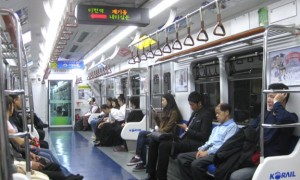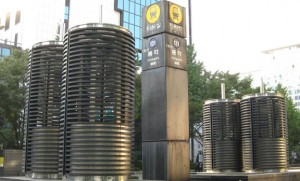From the perspective of ease-of-use for the western visitor, has Seoul, South Korea the most challenging subway in Asia? We certainly hope so. One element is its size. It serves a metropolitan area of 25 million people, and the subway’s map is so detailed that it looks like the schematic for a printed circuit board. There are nine separate lines, each supporting dozens of stations (Line 1, for example has 75 stations). Signage is sketchy in English, and station location maps, denoting stations up and down each line, are either missing or located away from turnstiles. Hand-out subway maps are not available in subway stations. The ticketing system is almost difficult to figure out if you don’t know Korean, and the English on the ticket machines doesn’t help much (contrast this with Bangkok, whose ticket machines are extremely simple for non-Thai speakers).
The good news is, once you’ve taken a day or so to figure it out, it becomes very serviceable, a great way to get around, and inexpensive. But user-friendly for the westerner? Nope. Don’t be in a hurry, the first time you use it. Your first day using the subway will be all about taking wrong paths through subway stations as you try to figure out signage.
To travel on the Seoul subway, you begin by buying a ticket from a machine for 1000 won per ride, or buy a charge chard for 3,000 won and add more won as you need it by placing the card in the machine and adding money. You’ll probably want to ask a friendly Korean for help. You do save 100 won or so a ride by using the card.
The three biggest problems for foreigners riding Seoul’s subway are the difficulty of buying a ticket, the lack of easily located route maps in stations, and being charged for crossing over a line at the same station to travel in the opposite direction. In addition, changing from one line to another in a connecting station can be tough, both because the relative distances can be long, and because the signage is terrible (try crossing over from line 3 to line 5 at the Jongno 3-ga station and you’ll see what we mean).
They’re all interrelated, as one newly arrived westerner’s story attests:
“A nice station manager took 5 minutes to show us how to buy a ticket at the Anguk station, so we bought a charge card in order to add more fare money when we need to. We arrived at our destination at the Sports Complex station, then attempted to return to Anguk. From the moment we walked into the station, we couldn’t find a route map telling us which platform was for east or west travel. When we entered a platform, we finally found a map. We were headed in the wrong direction. To cross to the other side, we had to use our subway charge card to go through the turnstiles again, which charged our card for a ride we never took! When we got to Anguk, our pass no longer worked, and we ended up crawling under a turnstile like a juvenile delinquent. We’d paid our fare, but the system didn’t work for us.”
Here at WoWasis, we’ve used subway systems all over Europe and Asia, and this is by far the trickiest. When you use this system, we’d recommend that you begin by finding a Korean who can tell you how the ticket machine works. Within a day, you’ll begin liking the Seoul Metro, but you’ll probably never love it, primarily, we think, because of the hard to find and the more-than-occasionally ambiguous signage. Happy travels!


Leave a Reply